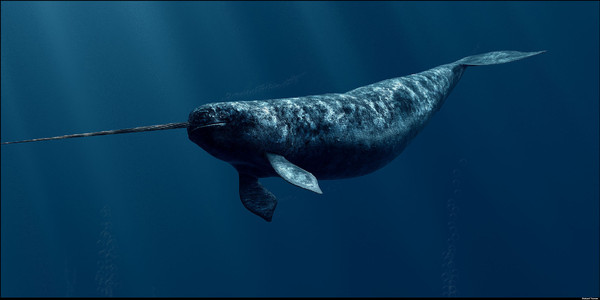

These majestic creatures make their homes in the dark, frigid waters of the Arctic. In fact, narwhal are some of the deepest swimming creatures, diving to at least 800 meters (2,625 feet) over 15 times per day to feed. But these creatures aren’t renowned because of their amazing diving abilitiess. Rather, it is their toothy protrusion that makes them so well known.
Narwhal are toothed whales with eccentric tusks, which are actually a front left canine tooth (as a side note, whoever passed up the opportunity to name this animal a “Sea Unicorn” should really regret their life choices). Honestly, their protrusions make them look like one of closest things to a unicorn in the animal kingdom.
Narwhal are medium sized whales, with males reaching up to 5.5 meters (18 ft), and the females averaging a bit smaller at 3.5 meters (11.6 ft). The tusk grows throughout life, and they can reach up to 3.1 meters (10 ft).
A 3 meter tusk is truly amazing, especially when one considers the length of a full grown male is just around 5 meters (which makes the tusk over half its body length). Despite looking like a deadly weapon, the tusk is hollow and weighs only around 10 kg (22 lb). Only about 15 percent of females actually grow tusks, and 1 in 500 narwhals can grow 2 tusks!

Unsurprisingly, these creatures have been surrounded by myths and legends for many years. Despite the fictionalized accounts surrounding the tusks, it is now generally accepted that their tusks are actually sensory organs. Think about your own teeth: they are incredibly durable due to the outside, protective layer of enamel. This hard covering protects the extremely sensitive, vulnerable inner parts of the blood and nerves. Well the narwhal’s tusk is polar opposite, with the sensitive part is on the outside and the dense, hard part making up the middle.
Since it has all those nerves on the outside of its massive tusk, it allows the whale to detect water pressure, temperature, and even salinity. It might even be able to detect barometric pressure when it’s above the water’s surface! So it’s definitely not a weapon, and it would certainly be susceptible to pain (and for the narwhal, this sensory organ is too valuable of an item to lose by fighting or hunting).